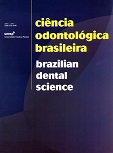Microleakage evaluation of composite restorations submitted to load cycling
DOI:
https://doi.org/10.14295/bds.2004.v7i4.213Abstract
The aim of this research was to evaluate the load cycling influence in resin composite restorations through marginal leakage analysis, in enamel and cementum. Forty bovine incisors were allocated in four groups (n=10): I – Z250 resin composite / Single Bond adhesive system; II – Charisma resin composite / Gluma One Bond adhesive system; III - Z250 resin composite / Single Bond adhesive system submitted to 1,000 cycles (10Kgf); group IV - Charisma resin composite / Gluma One Bond adhesive system submitted to 1,000 cycles. The class V restorations were located at cementum-enamel junction and the load was applied on the incisal edge. The samples were immersed in 2% buffered methylene blue solution. The samples were cross-sectioned and the leakage, which received a score, was evaluated through stereomicroscope (45 X ). Data were submitted to Kruskal-Wallis’ test (5%). Analysis showed no statistical differences among margins localized in enamel or in cementum, for loaded and unloaded groups (p>0,05). However, enamel showed better results than cementum in the same sample (p<0,05).Load cycling did not increase the microleakage in enamel or in cement margins. Comparing the infiltration degree in the same sample, the staining solution penetration was higher in cementum margins, for both loaded and unloaded groups.
Downloads
Downloads
Published
How to Cite
Issue
Section
License
Brazilian Dental Science uses the Creative Commons (CC-BY 4.0) license, thus preserving the integrity of articles in an open access environment. The journal allows the author to retain publishing rights without restrictions.
=================




























